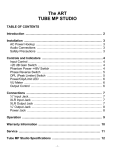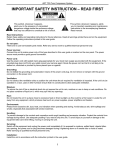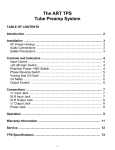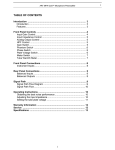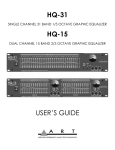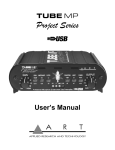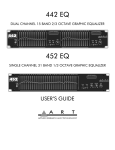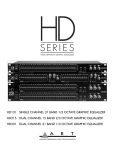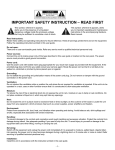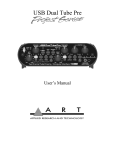Download Art DIO Specifications
Transcript
The ART DI/O TABLE OF CONTENTS Introduction ......................................................................................... 2 Installation ........................................................................................... AC Power Hookup ............................................................................. Audio Connections ............................................................................ Safety Precautions ............................................................................ 3 3 3 3 Controls and Indicators ....................................................................... 4 Input Gain Control ............................................................................. 4 Sample Rate Switch .......................................................................... 4 Sample Rate LED Indicators ............................................................. 5 Signal Level LED Indicators ............................................................... 5 Tube Warmth Control ........................................................................ 6 Power LED Indicator ......................................................................... 6 Connections ........................................................................................ ¼” Input Jacks.................................................................................... ¼” Output Jacks ................................................................................ S/PDIF Output Jack ........................................................................... S/PDIF Input Jack ............................................................................. Power Jack ....................................................................................... 7 8 8 8 8 9 Operation ........................................................................................... 10 Warranty Information ........................................................................ 14 Service ............................................................................................... 15 DI/O Specifications ............................................................................ 16 -1- INTRODUCTION Designed to help ease the high-resolution stereo 24-bit from 44.1 to 96kHz. In synchronization allows for 22kHz to 100kHz. transition to the digital world, the DI/O offers A/D-D/A conversion at switchable sample rates external sync mode, the DI/O’s intelligent automatic sync to outboard equipment from The DI/O can be used in a wide variety of applications including recording, project, and home studios. Let the DI/O be the interface for your “classic” analog signal processing gear in an all-digital production environment. It’s the perfect interface for any computer-based recording system and gets the A/D-D/A conversion process out of the noisy digital environment. You can use the DI/O as your instrument’s direct-to-digital interface, thanks to its high input impedance. Upgrade the A/D-D/As on your DAT machine or older digital I/O equipment with the DI/O’s high-resolution converters. Get more dynamic range on new samples and overdubs. You can loop thru the DI/O to add “analog” warmth and musicality to an existing digital track. The latest refinements in ART’s award winning tube pre-amp design are integrated on the front end, before the A/D converter, for analog gain and dynamic range control. At the clean setting, the tube circuitry is virtually bypassed and the A/D sees a “straight wire with gain” signal. As you increase the control the signal goes from ultra clean and transparent, thru silky, to smooth, to warm, to fat. At the warm end the tube becomes the dominant gain element, enhancing lower and mid level signals and soft limiting peaks and overshoots before they hit the A/D. FEATURES: • 2 channels of A/D and 2 channels of D/A conversion • High Resolution 24-bit, 96kHz, 128x oversampling converter • 44.1, 48, 88.2, 96kHz switch-selectable sample rates • Intelligently syncs to external sample rates from 22kHz to 100kHz • S/PDIF Coaxial, Digital inputs and outputs, RCA type jacks • Hand-selected 12AX7A dual triode tube • Fully variable tube character from transparent to warm • ¼” High impedance stereo inputs and ¼” line level stereo outputs • Variable input gain from 0dB(unity) to +20dB -2- INSTALLATION The DI/O may be used in a wide variety of applications and environments. Self-contained in an all-steel enclosure, the DI/O is designed for continuous professional use. Because the unit is compact and lightweight, mounting location is not critical. However, for greater reliability we recommend that you not place the DI/O on top of power amps or other sources of heat. The tube circuitry needs about a minute to “warm up” from a cold power up. AC POWER HOOKUP The DI/O has an external power supply designed to operate at 115 VAC @ 50 to 60 Hz. Units manufactured for use outside the United States of America have been modified to comply with the required electrical specifications. Only use the adapter that came with the DI/O. If the adapter becomes lost or damaged; contact ART Customer Service for replacement. If you need to purchase one locally, just make sure that you specify 9 Volt AC output (not DC), at 800 ma. AUDIO CONNECTIONS Audio connections to and from the DI/O are unbalanced ¼” (Tip = Hot (+), Sleeve = Ground). We recommend that you turn down the INPUT GAIN control whenever changing connections to the inputs. SAFETY PRECAUTIONS Warning: To avoid the risk of shock or fire, do not expose this unit to moisture. Refer all servicing to qualified personnel. Do not remove the metal cover; there are no user-serviceable parts inside. You should only use the power adapter that came with this unit or one obtained from ART’s Customer Service Department. -3- CONTROLS & INDICATORS INPUT GAIN CONTROL The Input Gain control allows you to add gain to the input signal before the tube and A/D converter. Turn the control clockwise to increase gain and counterclockwise to decrease gain. At the fully counterclockwise position (0dB), incoming signals are passed at unity gain to the A/D converter. At this setting the inputs can handle “hot” signals, up to +20dBu, before clipping the A/D. When the Input Gain control is at the fully clockwise position (+20dB), the incoming signal is boosted in level before the A/D. This allows you to increase low level signal sources by up to 20dB, to maximize the input dynamic range of the A/D. In normal operation you would increase the Input Gain control until the red “0dB” LED just lights on signal peaks. SAMPLE RATE SWITCH Use the Sample Rate Switch to select the desired sample rate. Each time you press the switch, it increments through the available choices while the LEDs beside it show the current state. The DI/O remembers the sample rate setting and powers up at the same sample rate that it was in before power was removed. This allows you to, in many applications, set the sample rate for your system once and leave it. -4- SAMPLE RATE LED INDICATORS The Sample Rate LED Indicators show the current sample rate that the DI/O’s A/D and D/A are operating at. When set to one of the internally generated sample rates (44.1, 48, 88.2, or 96kHz), the DI/O provides the Master clock source from its internal crystal clock. When set to the External Sync position, the DI/O will use the S/PDIF In jack as the source of its Master clock. It will synchronize to, and track, sample rates from 22kHz to 100kHz. The green (Ext.) LED indicator will light solid as long as the source has valid audio sync. It will flash if the data on the S/PDIF input jack does not contain valid audio data. When this occurs the D/A will mute its audio outputs to prevent unwanted noise. The A/D will still digitize audio and track the external Master clock. SIGNAL LEVEL LED INDICATORS The three Signal Level LED Indicators are designed to help set levels before the A/D, to maximize your dynamic range. The green (-20dB) LED comes on when the signal at the A/D is 20dB below full-scale digital clipping on signal peaks. It just starts to come on when the average signal is around 30dB below clipping. You should increase your input signal level, or the DI/O’s Input Gain until this light is on solid whenever there is signal for best performance. The red (0dB) LED comes on when the signal at the A/D is 3dB away from full-scale clipping. With most audio material, you would increase the input signal or Input Gain until this light just starts to come on during signal peaks. The yellow (Warm) LED comes on whenever the tube is adding warmth or character to the signal. This is a function of both the input signal level and the Tube Warmth control. -5- TUBE WARMTH CONTROL This control allows you to vary the tube circuits warmth contribution to the audio signal chain. At the Clean end, there is essentially no tube processing and the yellow Warm LED should not light. As you turn up the control, the drive to the tube is increased while its output is adjusted, to maintain a fairly constant output signal to the A/D. At higher signal levels you will see the yellow (Warm) LED start to come on, indicating that the tube circuit is doing some of the processing. The audible effect is subtle at lower settings. At the full Warm position, you will see the Warm LED on more of the time, even at lower signal levels. Audibly, at this setting, the tube adds low-order harmonics that tend to musically “thicken” the signal. Signal peaks are also softened, rather than hard-clipped. Both of these effects are what give the DI/O that “Analog Tape Saturation” sound at higher levels with higher settings of the Warmth control. POWER LED INDICATOR The green Power LED lights solid to indicate that the DI/O is receiving adequate power from its external power source. If it ever flickers, check the connections, power adapter, or line voltage. -6- CONNECTIONS variety of equipment. All inputs and outputs are located on the rear panel. Standard ¼” audio inputs and outputs make patching simple. -7- ¼” INPUT JACKS The ¼” Input jacks are for instrument and line level signals. They have a high input impedance to minimize any loading effects on instrument pickups. They can also handle up to +20 dBu signals for line level signal sources. If nothing is plugged into the Input jacks, they automatically switch to get their signal from the ¼” Output jacks. This allows you to loop the digital signal thru the DI/O. In this configuration you only need S/PDIF in and out connections. ¼” OUTPUT JACKS The ¼” Output jacks have a low output impedance to drive a wide variety of loads. They deliver a +20dBu signal level when the D/A is at digital full scale. The output level at the jacks is solely a function of the digital signal. S/PDIF OUTPUT JACK The digital output jack on the DI/O is an RCA type that outputs S/PDIF stereo signals over coaxial shielded cable. The data format is S/PDIF stereo 24bit data at up to 100kHz. Due to this wide bandwidth, we recommend that you use high quality, low loss, fully-shielded cabling for both of the S/PDIF connections. S/PDIF INPUT JACK The digital input jack on the DI/O is an RCA type that receives S/PDIF stereo signals over coaxial shielded cable. The data format is S/PDIF stereo 24bit data at up to 100kHz. This jack also serves as the Master clock input when using the DI/O in External Sync mode. -8- POWER JACK An external 9 Volt AC adapter powers the DI/O. Plug the adapter into the PWR jack and then into a power outlet. Only use the adapter that comes with the DI/O. If the adapter ever becomes damaged, immediately discontinue use. They can be purchased locally or directly from ART. Just make sure that you specify 9 Volt AC output (not DC), at 800 ma. Fill in the following information for your reference: Date of purchase ___________________ Purchased from ___________________ SERIAL NUMBER ___________________ -9- OPERATION The main function of the DI/O is to provide a high-quality alternative to the digital audio converters of your computer’s soundcard. Simply plug the analog output from your instrument, mixer, or preamp into the DI/O’s 1/4” Inputs and connect the DI/O’s S/PDIF Output to your soundcard. Next, decide whether your DI/O or soundcard will provide the digital clock source. Only one device, called the Master, can provide the digital clock; this ensures that all other devices synchronize themselves to just one source and correctly interpret the transmitted digital information. Devices other than the Master must be put into “External” clock mode to properly work together. Note: Due to the DI/O’s high quality converters, we recommend that when possible, you use the DI/O as the Master clock. To make the DI/O the Master, first set up your soundcard to receive an external clock source. (Consult your soundcard’s manual for information on how to do this.) Next, use the DI/O’s Sample Rate switch to select the desired sample rate. For example, to select a sample rate of 96kHz, repeatedly press the DI/O’s Sample Rate switch until both the top (48/96) and middle (x2) lights are lit. The graphic on top of the DI/O is provided to assist you with the different configurations. If instead you wish to use your soundcard as the Master clock source, put the DI/O into External Sync mode by pressing the Sample Rate switch until only the bottom (Ext.) light is lit. Select the desired sample rate on your computer. (Consult your soundcard’s manual for information on how to do this.) Once the clock source and sample rate have been set, use the DI/O’s Input Gain control to optimize the recording level. Generally, you should watch your software’s Input Meters and adjust the DI/O’s Input Gain control to a level just below clipping. (Again, check your soundcard’s or software’s manual for information on setting optimal levels.) - 10 - The DI/O contains tube circuitry that can be used to warm-up digital recordings. The amount of tube warmth is increased by turning the DI/O’s Tube Warmth knob clockwise. This control lets you increase the amount of tube drive without increasing the DI/O’s output level. You can add warmth to any sound without having to readjust the levels going through the DI/O. If you wish to bypass the tube circuit completely and simply use the DI/O for its high-quality analog to digital converters, turn the Tube Warmth control fully counter-clockwise to the Clean position. OTHER APPLICATIONS: USING BOTH DIGITAL INS AND OUTS The DI/O is an excellent tool for warming-up audio and then converting it to high-quality digital audio. It is also an excellent tool for warmingup audio that’s already in the digital domain, such as from the output of a soundcard or digital mixer. The DI/O can both accept and return sound in the digital domain, thus making it simple to insert into your existing system. For example, when mastering a mix to DAT, insert the DI/O between your soundcard’s S/PDIF Output and the DAT’s S/PDIF Input. Adjust the DI/O’s Sample Rate to External. Use the DI/O’s Tube Warmth control to enhance your digital mixes and help TO IMPROVE MONITORING SOURCES Another great use of the DI/O is for monitoring the output of DAT decks, digital workstations, and digital mixers. In most cases, the DI/O offers superior performance to the on-board converters of your other gear, which adds more life to digital, pre-mastered recordings. For example, connect your DAT deck’s S/PDIF Output to the DI/O’s S/PDIF In and send the DI/O’s 1/4” Outputs to the 2-track (Monitor) returns on your mixing board. - 11 - USING BOTH ANALOG INS AND OUTS The DI/O also can be used on completely analog signal paths. For example, during a live performance, the DI/O can sweeten up the harsh sound of some keyboards and synthesizers. Simply use the 1/4” Input and Output jacks to insert the DI/O between your keyboards and amplifiers. Use a single RCA cable to loop the DI/O’s S/PDIF In to its S/PDIF Out. Set the DI/O’s Sample Rate control to 96kHz (for transparent digital audio pass-through) and adjust the Input Gain and Tube Warmth controls as desired. The Input Gain control can be raised to further optimize the output signal level if going over long cable runs (to the amps, mixing board, etc.). SPECIAL EFFECTS For industrial, metal, or just “flavor” textures, experiment with the DI/O. Overdriving the tube can add interesting textures when used on vocals and other instruments, especially if you are going for analog tape saturation effects. When using both analog Ins and Outs (see above) it is possible to cascade the left channel into the right channel to obtain doubly overdriven effects. Simply plug your source into the DI/O’s Left 1/4” Input, connect the DI/O’s Left 1/4” Output to its Right Input, and send the Right Output to your mixing board, analog recorder, etc. Turn up the Input Gain and Tube Warmth controls until you achieve the desired effect. No harm will come to the DI/O with this type of experimentation, though you may need to lower the signal level going into the next piece of equipment. Be sure to have monitoring levels turned DOWN before “testing” the sound. TUBE REPLACEMENT The Tube in your DI/O should last for many years. They are handsorted for optimal performance in our specific circuits. In the event that you need to replace them, A R T suggests that you do so with tubes available from A R T. These are matched to the DI/O and will yield consistent sonic results. You can replace the tubes with other brands, however A R T has no responsibility for the resulting sound quality. - 12 - They may sound better, they may sound worse. The choice is yours. Please realize that unauthorized alterations to the DI/O will result in voiding the warranty. For more application ideas, information, and suggestions on complementary equipment that can be used with the DI/O, visit our website at: http://www.artproaudio.com - 13 - WARRANTY INFORMATION Limited Warranty Applied Research and Technology will provide warranty and service for this unit in accordance with the following warrants: Applied Research and Technology, (A R T) warrants to the original purchaser that this product and the components thereof will be free from defects in workmanship and materials for a period of three years from the date of purchase. Applied Research and Technology will, without charge, repair or replace, at its option, defective product or component parts upon prepaid delivery to the factory service department or authorized service center, accompanied by proof of purchase date in the form of a valid sales receipt. Exclusions: This warranty does not apply in the event of misuse or abuse of the product or as a result of unauthorized alterations or repairs. This warranty is void if the serial number is altered, defaced, or removed. A R T reserves the right to make changes in design or make additions to or improvements upon this product without any obligation to install the same on products previously manufactured. A R T shall not be liable for any consequential damages, including without limitation damages resulting from loss of use. Some states do not allow limitations of incidental or consequential damages, so the above limitation or exclusion may not apply to you. This warranty gives you specific rights and you may have other rights, which vary, from state to state. For units purchased outside the United States, an authorized distributor of Applied Research and Technology will provide service. - 14 - SERVICE The following information is provided in the unlikely event that your unit requires service. 1) Be sure that the unit is the cause of the problem. Check to make sure the unit has power supplied, all cables are connected correctly, and the cables themselves are in working condition. 2) If you find the unit to be at fault, write down a complete description of the problem, including how and when the problem occurs. Please write down a description of your complete setup before calling Customer Service. 3) Contact our Customer Service department at (716) 436-2720 for your Return Authorization number or questions regarding technical assistance or repairs. Customer Service hours are 9:00 AM to 5:30 PM Eastern Time, Monday through Friday. 4) Pack the unit in its original carton or a reasonable substitute. The packing box is not recommended as a shipping carton. Put the packaged unit in another box for shipping. Print the RA number clearly on the outside of the shipping box. Print your return shipping address on the outside of the box. 5) Include with your unit: a return shipping address (we cannot ship to a P.O. Box), a copy of your purchase receipt, a daytime phone number, and a description of the problem. 6) Ship only your unit and its power supply (keep your manual!) to: APPLIED RESEARCH AND TECHNOLOGY 215 TREMONT STREET ROCHESTER, NEW YORK 14608 RA# ____________________ - 15 - DI/O SPECIFICATIONS A/D – D/A Converter Sample Rate External Sync Range Digital Interface Dimensions Weight Frequency Response Dynamic Range (D/A) Maximum Input Gain Maximum Input Level Maximum Output Level Input Impedance Output Impedance Tube Type Power Requirements 24-Bit, 96kHz, 128x oversampling 44.1, 48, 88.2, 96kHz switch selectable 22kHz to 100kHz S/PDIF Coaxial, In and Out, RCA jacks 5.25”D x 5.375” W x 2.0”H 1.5 lbs. 10Hz to 30kHz, +/-.5dB 108 dB (A-wtd.) 105dB (20-20kHz) typical +20dB +20dBu +20dBu 100K ohms 220 ohms 12AX7A, Dual Triode, Hand Selected USA – 9VAC @ .8A (typ.) Export units configured for country of destination ART maintains a policy of constant product improvement. ART reserves the right to make changes in design or make additions to or improvements upon this product without any obligation to install same on products previously manufactured. Therefore, specifications are subject to change without notice. Applied Research & Technology 215 Tremont Street Rochester, NY 14608 USA (716) 436-2720 (716) 436-3942 (FAX) www.artproaudio.com © 2000 Applied Research & Technology - 16 -
















